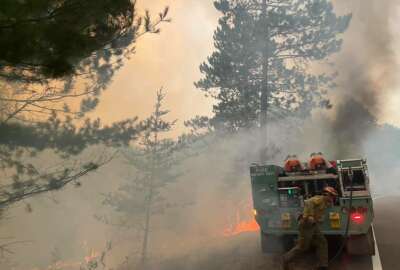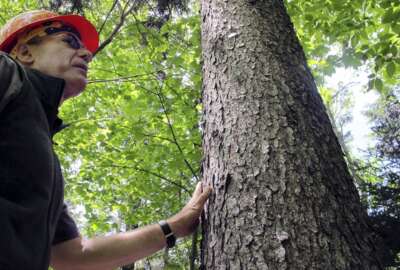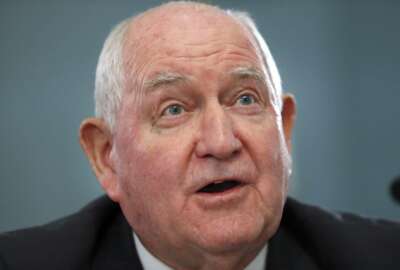
Forest Service publishes a plan to mitigate the risk of wild forest fires
Wildfires and forest fires have become almost a year round phenomenon. It can't continue, so the U.S. Forest Service has a new strategy.
Best listening experience is on Chrome, Firefox or Safari. Subscribe to Federal Drive’s daily audio interviews on Apple Podcasts or PodcastOne.
Wildfires and forest fires have become almost a year round phenomenon. It can’t continue, so the U.S. Forest Service has a new strategy aimed at protecting homes and towns in danger, and for the resilience of woodlands themselves. Federal Drive with Tom Temin spoke with Brian Ferebee, Forest Service program manager, for the details.
Interview transcript:
Tom Temin: Mr. Ferebee. Good to have you on.
Brian Ferebee: Good morning, Tom. How are you?
Tom Temin: Alright, so this has been a ongoing concern, I guess, just the number of wildfires. Let’s begin at the beginning. Is it fair to say they have become much more a year round, rather than a seasonal type of phenomenon?
Brian Ferebee : Yes, that’s correct, Tom, we have traditionally used to see a fire season May to September, October, but now we’re essentially seeing wildfires throughout the entire year. So we definitely have moved from a fire season to a fire year.
Tom Temin: And with that phenomenon, then it’s not just forest land that is being wrecked. But increasingly, we see on the headlines and watch the newscasts, that it’s towns and houses and real property also that’s taking the brunt.
Brian Ferebee: Correct. The situation that we’re facing, we really look at it as all lands issue. We’re seeing our national forests, we’re seeing private land, forests, we’re seeing communities all affected in a very negative way, in many respects from the wildfire situation we’re experiencing currently.
Tom Temin: Alright, so for the Forest Service, now there’s a new 10-year strategy. And let’s begin with what lands can you deal with as the Forest Service? Because a lot of these start on state lands, and maybe even on private property. So can the Forest Service kind of help with land that is not directly under Forest Service management?
Brian Ferebee: Yes, we can we partner with a whole host of partners to really address what I would say the agency feels as an all lands issue. And so we work closely with private landowners, with other federal agencies, with state agencies, as well as with NGOs, to really look at how to address this wildfire situation.
Tom Temin: I was gonna say the Park Service has got to be part of this because a lot of your lands are contiguous to Park Service lands too, aren’t they?
Brian Ferebee: Absolutely. They have some of the same concerns that we would have.
Tom Temin: And would that also include the Bureau of Land Management where, you know, they’ve got lands in different parts? I mean, there’s, it’s all over the place, but are some of their areas forested also that would be of danger to the leasing and so on operations?
Brian Ferebee: Yes. So with Department of Interior, not only are they concerned about their forested lands, but they’re also concerned about their range lands, which are also being impacted from wildfire.
Tom Temin: Sure. Ranges can burn, grasslands burn as well as forests, correct?
Brian Ferebee: Correct.
Tom Temin: All right. So tell us what’s in the 10-year strategy, what is it you have developed here?
Brian Ferebee: So, the 10-year strategy really acknowledges a little bit about what we just talked about, it realizes and acknowledges that, you know, over quarter of the contiguous United States is in high to moderate condition when it comes to wildfire. And that really is devastating communities, destroying resources, affecting jobs, as well as threatening infrastructure. So, the 10-year strategy acknowledges that and acknowledges that that will continue as we continue to see accumulating fuels, as we continue to see climate change, and as we continue to see these wildland-urban interfaces continue to be developed. And so it tells us, in order to have a paradigm shift, we need to look at really treating significant amount of more acres than we currently have in the past. And we need to do it in a way that’s scientifically founded. And so we’re using science as a foundational piece to help us determine where we go, and how we lay out those projects designed in order to mitigate impacts from wildfire.
Tom Temin: And you can’t really do anything about the climate directly. But the fuels issue is a big one. And that gets to how forest lands are managed, doesn’t it?
Brian Ferebee: Absolutely. Right now we treat somewhere between two to three million acres a year. And the strategy says over a 10-year period, we would need to treat an additional two million acres a year. So we’d be looking at treating between four and five million acres a year in order to really change the trajectory of wildfire and that’s just on National Forest System lands. When we go and incorporate other federal lands, states, tribal and private lands, like you and I just spoke about, that is an additional 30 million acres that need to be treated.
Tom Temin: Yeah, that’s a tall order. We’re speaking with Brian Ferebee. He’s a program manager at the U.S. Forest Service. And when you say treat acreage, what does that actually entail?
Brian Ferebee: It entails things such as prescribed burning, mechanical thinning, commercial timber sales, you know, every tool that we have in our toolbox we would use in order to really treat the vegetation to reduce fuels. And you know, we do it as an agency. We do it with our partners, and we also contract work out as well. And so here again, there’s a whole host of ways of which we would actually be able to deliver on the work.
Tom Temin: Is there a challenge in that some areas love their trees so much that they love every tree too much? And they don’t like thinning because you have to remove some trees and cut them down in order to spare the other trees or at least mitigate the danger. Is that something you’d run into?
Brian Ferebee: Social acceptance of the work we do is a critical piece of actually the work. And so many people live in forests, as well as visit the national forests, because they love forested areas. And so when we start to talk about treating the landscape, removing trees removing brush, there is this relationship that many of our public have with that land and so having conversation to help them understand, actually treating the land actually helps it in the long term is work that we do have to do. But there are definitely members of our society that absolutely love their trees.
Tom Temin: And by the way, does the Forest Service staff itself go in and do the work on your lands? Or do you hire contractors? Or can volunteers even help?
Brian Ferebee: You know, so Tom, we have crews ourselves that do the work, we also contract that work out, as well as we use agreements and we work with a number of different private entities to do the work and we use volunteers to do the work.
Tom Temin: And by the way, while you’re at it, do you get to some of the invasive vines that are, I mean, you drive around Washington, DC, you wonder if there’s ever going to be any forest left when you see those vines twisting around all the trees.
Brian Ferebee: So a part of our treatment plan has to be maintenance. And when we get to the maintenance side, you really do have to think about invasive and noxious weeds that could come in to that site if you don’t take and treat them.
Tom Temin: And what is the value? I’ve read that wildfires and forest fires have been happening long before mankind started moving in nearby and into the forests, and that they actually in some ways benefit the forest in the long term. And how do you know what’s a good fire and what’s a fire you don’t want to have?
Brian Ferebee: A low intensity wildfire, a fire, like many of the vegetative communities, evolved with over hundreds of years, is really what you like. It stimulates growth, it doesn’t create severity and burn off seed sources and the soul itself. But it actually allows for regeneration, as opposed to some of the wildfires that we’re seeing now, where they’re so severe, that they really not only burn all the trees off, but they burn to seed source as well as they remove soil from erosion that takes place after a fire. And really, you’re essentially starting over in that landscape.
Tom Temin: Yeah, so that is a hotter fire. In other words, and a more lengthy fire than would occur naturally, if man hadn’t been changing the way the forests kind of bear themselves.
Brian Ferebee: Very much more a much hotter fire in what we’re trying to mitigate by actually putting fire back on the landscape, but in a condition that won’t create that kind of severity.
Tom Temin: So getting back to the strategy, you have written this, and you have noted that another 30 million acres a year needs to be treated beyond half of the land that the Forest Service needs to get to that they can get to so 35, 36 million acres, what does the plan, say to how to get to that level, because it seems like the state and local partners would need to be part of this.
Brian Ferebee: So it’ll really take a coalition of partners to really address this work. And what we’ve done is we’ve gone back and looked at the fire history in some of these landscapes and we looked at where we have significant infrastructure, and where that interface could possibly take place. And what we’re seeing is that 80% of the exposure on the landscape on national forest is in really 10% of that forested type. And so if we can focus in those areas, we really believe we can make a difference and mitigate impacts to communities and values that many of the American public care about. But absolutely, we have to do it with a coalition of partners.
Tom Temin: And by the way, you know, most of the wildfires seem to be in the West in California and just generally west in the United States. What is it about the East that doesn’t seem to invite this phenomenon so much?
Brian Ferebee: The East has had a rich history of use of prescribed fire on the landscape. And that tradition and that history is kind of embedded and born in the culture. It’s accepting of prescribed fire. It’s used to wildfire. And as a result, you see those ecological conditions in a much better state, if you will, then some of our places out west.
Tom Temin: Interestingly, they used to let us burn leaves in the fall, but now you can’t because of the air pollution.
Brian Ferebee: Yeah, there’s definitely a lot of things you have to pay attention to when you’re actually engaging in using using fire.
Tom Temin: Yeah, it’s a big balancing act, isn’t it? The whole process?
Brian Ferebee: Correct.
Tom Temin: Brian Ferebee is a program manager at the U.S. Forest Service. Thanks so much for joining me.
Brian Ferebee: Thank you, Tom for having me.
Copyright © 2025 Federal News Network. All rights reserved. This website is not intended for users located within the European Economic Area.
Tom Temin is host of the Federal Drive and has been providing insight on federal technology and management issues for more than 30 years.
Follow @tteminWFED
Related Stories





